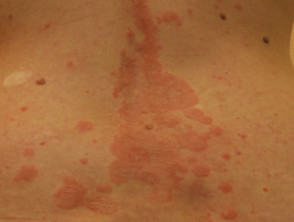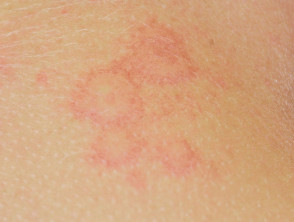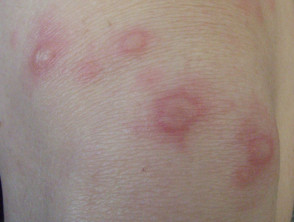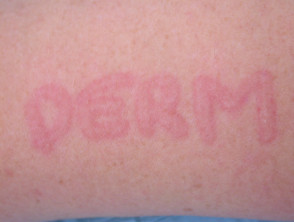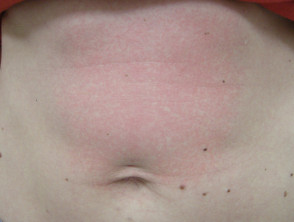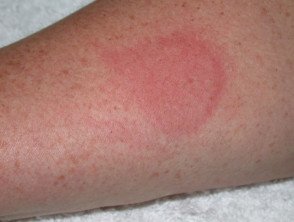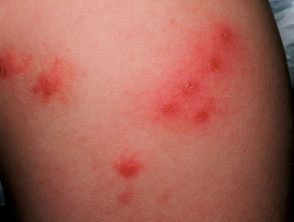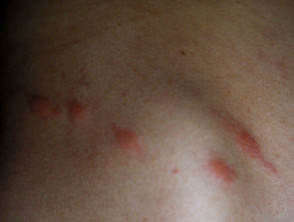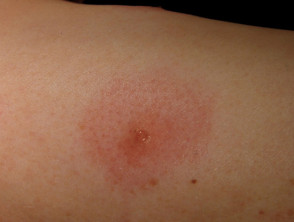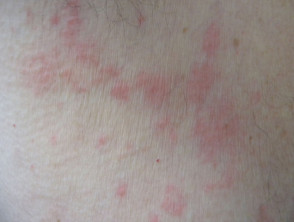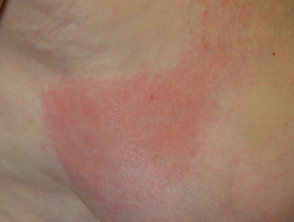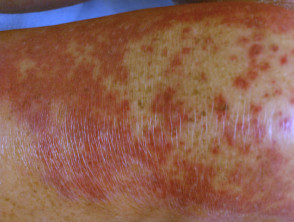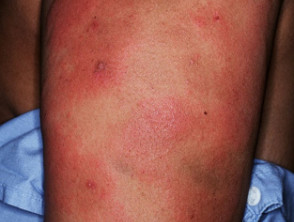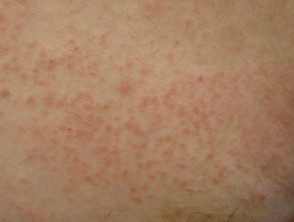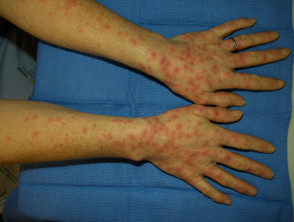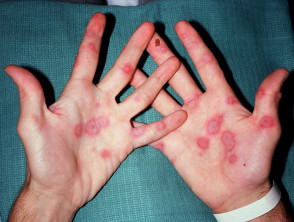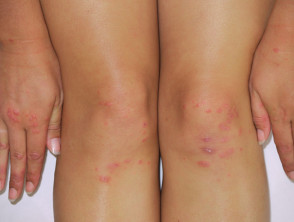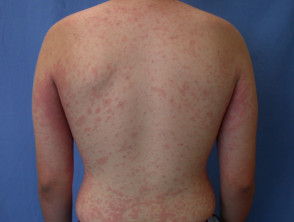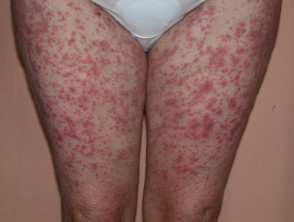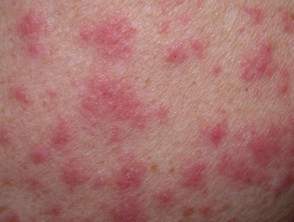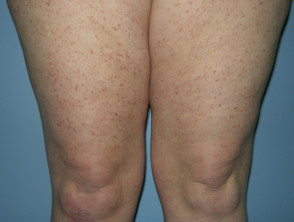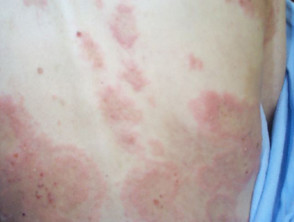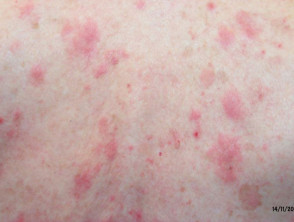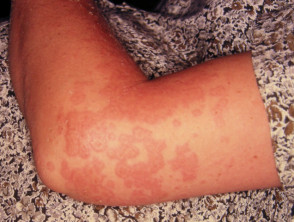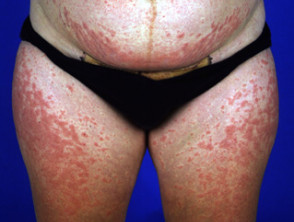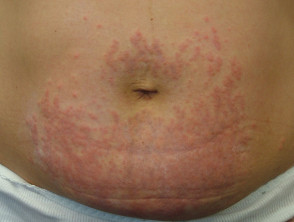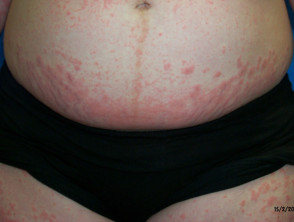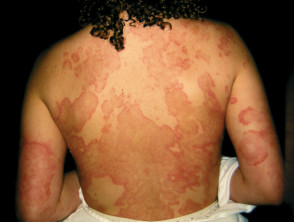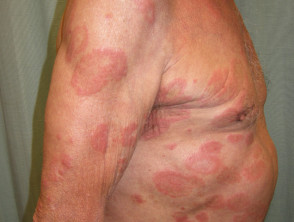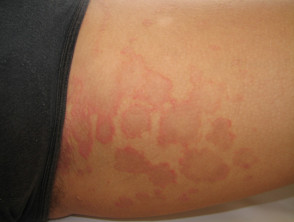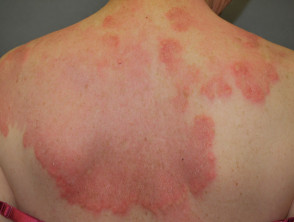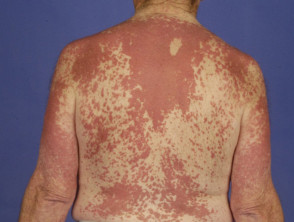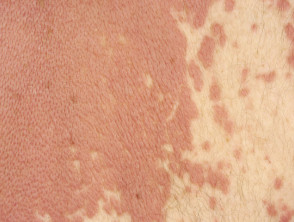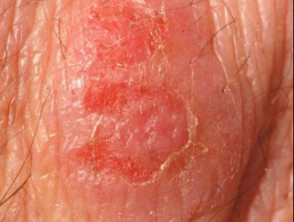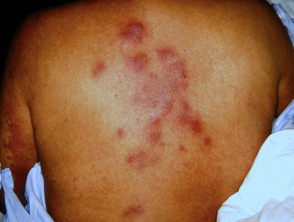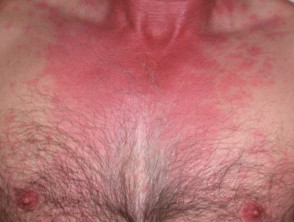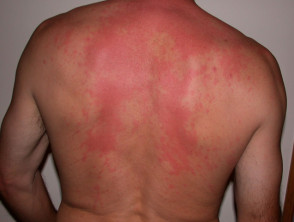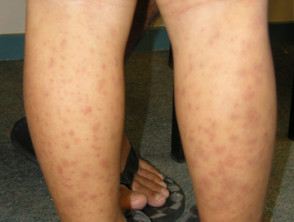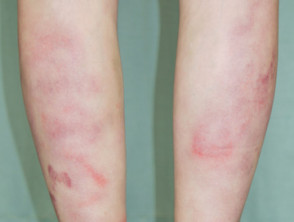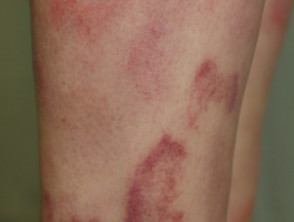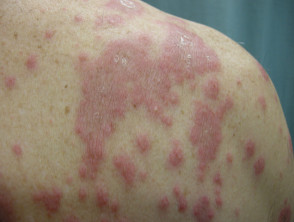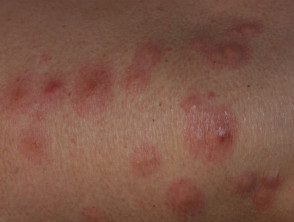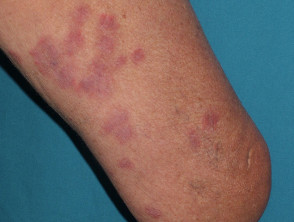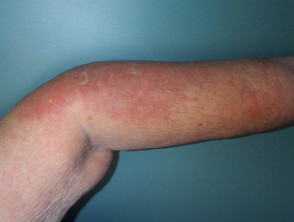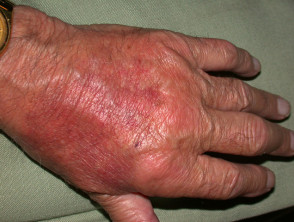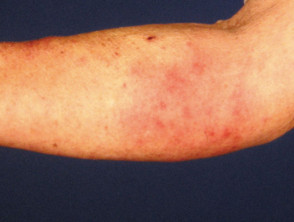Introduction
This topic provides a differential diagnosis for urticaria and for urticaria-like conditions that resemble urticaria but are not caused by wealing.
What is urticaria?
Urticaria describes a group of conditions in which there are weals (or weals) in the skin, itchy white or red lumps. Urticaria can occasionally be a sign of systemic disease.
Ordinary urticaria
Spontaneous or 'ordinary' urticaria is divided into acute urticaria (lasting a few hours or days or up to six weeks) and chronic urticaria (persisting more than six weeks, and sometimes life-long).
- Acute urticaria is self-limiting and often related to infection, and less often due to food or is drug-induced.
- Chronic urticaria has no specific external cause (thus 'spontaneous') and is considered autoimmune in most cases.
- Ordinary urticaria may be accompanied by angioedema.
The weals are well defined raised lesions with a smooth surface. They may be red or white, surrounded by a red or white flare. Weals range in size from a few millimetres to many centimetres in diameter. The shape also varies: round, polycyclic (overlapping circles), annular (ring-shaped), geographic (like a map). They are randomly distributed on the body and may affect any site. They last no more than 24 hours and do not leave any marks behind.
Ordinary urticaria: asymmetrical weals that clear within 24 hours
See more about ordinary urticaria.
Inducible urticaria
Chronic inducible urticaria (previously known as physical urticaria) arises in response to an external factor. Classification is according to the provoking factor: stroking the skin in dermographism (skin writing), acetylcholine released during sweating in cholinergic urticaria, cold air or water in cold urticaria, local heat in heat urticaria, a contact factor in contact urticaria, water of any type or temperature in aquagenic urticaria, sun exposure in solar urticaria and firm pressure in delayed pressure urticaria. Physical urticarias have the following characteristics.
- Weals are induced at the site of the provoking factor
- Weals last about 15 minutes, nearly always less than one hour (with the exception of delayed pressure urticaria, which lasts hours to days)
Inducible urticaria: short-lasting weals at the site of provoking factor
What are urticaria-like skin lesions?
Urticaria-like skin lesions are reddish or skin-coloured flat patches or swellings with a smooth surface that persist for more than 24 hours.
Insect bites
Insect bites often result in itchy bumps (papules) or weals. Their characteristics include:
- Initial sting is often felt
- On exposed sites
- Central blister (vesicle)
- Groups of lesions, often distributed asymmetrically
- More commonly arise in summer and autumn months
- Individual lesions persist for days to weeks
- Brownish discolouration that persists for months is often seen in a skin that tans easily.
Children and, less frequently, adults may develop papular urticaria, which is interpreted as a hypersensitivity reaction to insect bites. No initial sting is felt, and old lesions may reappear.
A biopsy reveals an inflammatory infiltrate that includes eosinophils and spongiosis of the epidermis.
Insect bites: grouped urticarial lesions with central punctum or blister
Urticarial dermatitis
Urticarial dermatitis presents with both urticaria-like and eczema-like lesions.
- Urticarial dermatitis usually affects elderly patients
- Persistent red itchy plaques may have a smooth surface (urticaria-like) or dry scratched surface (eczema-like)
- They are distributed symmetrically on the trunk, upper arms and thighs
- In some cases, urticarial dermatitis is an adverse reaction to a drug.
A biopsy may be reported as dermal dermatitis with mixed inflammatory cells in the dermis and minimal spongiosis in the epidermis.
Urticarial dermatitis can be an early sign of bullous pemphigoid. Eventually, tense blisters appear. Biopsy features eosinophils and subepidermal clefting with positive staining on direct immunofluorescence.
Urticarial dermatitis: persistent red plaques with a smooth or dry surface
Contact dermatitis
Contact dermatitis sometimes appears urticarial rather than eczematous, with most of the inflammation in the dermis rather than the more superficial epidermis.
- It appears at the site of contact with the responsible agent
- It may arise in irritant contact dermatitis or allergic contact dermatitis
- Lesions clear up over days to weeks
- Patch tests may reveal an allergen in allergic cases
Contact dermatitis should be distinguished from contact urticaria, which is a short-lasting type of physical urticaria (see above).
Contact dermatitis: sometimes predominantly dermal
Erythema multiforme
Classic erythema multiforme presents with an acute eruption of target-shaped lesions on the hands, feet, knees and elbows. However target-shaped lesions may also be seen in ordinary urticaria.
- Target lesions are urticaria-like plaques characterised by concentric rings
- In erythema multiforme, blisters often arise in the centre of the plaques
- Individual lesions persist for ten days to 3 weeks
- Mucosal lesions occur in more severe cases
- Erythema multiforme may be recurrent, usually due to herpes simplex virus infection
A biopsy is usually characteristic.
Erythema multiforme: crops of target lesions on hands and knees
Urticarial drug eruptions
Drug eruptions include urticaria and urticaria-like eruptions. Individual lesions resolve within hours in drug-induced urticaria and persist for days in urticaria-like eruptions. They are often described as morbilliform or maculopapular eruptions. Characteristics of drug eruptions include:
- The rash starts within 14 days of a new medication (except in drug hypersensitivity syndrome, when they arise within eight weeks of starting a new medication)
- They arise sooner on re-challenge
- The medication may have already been stopped when the rash appears
- Red macules (small flat spots) and papules (small raised spots) may merge to form large patches (large flat areas) and plaques (large raised areas)
- The rash is symmetrical and tends to be most severe on the trunk
- The rash may or may not be itchy
- There may or may not be a low-grade fever
- As the lesions fade, the surface peels
- Dark marks may persist for days to weeks
A biopsy reveals a subtle inflammatory infiltrate that includes eosinophils, and lymphocytes and apoptotic keratinocytes in the epidermis.
Drug eruptions: symmetrical urticated papules and plaques
Urticaria pigmentosa
Urticaria pigmentosa is a form of cutaneous mastocytosis in which there are brown macules and papules.
- Urticaria pigmentosa is mostly seen in infants and improves with age
- It may also arise in adults when it tends to persist
- Lesions may affect trunk and limbs, and less often scalp and face
- The lesions urticate when they are rubbed, or spontaneously, i.e. the papules swell into weals, and these persist for up to an hour
- Lesions may blister in young children
- There may be few to hundreds of lesions
- Systemic involvement may result in flushing and faintness
A biopsy may reveal increased numbers of mast cells, but these can be difficult to identify, and the tissue may look the same as normal skin.
Urticaria pigmentosa: brown spots that urticate
Autoimmune blistering diseases
The subepidermal autoimmune blistering diseases may initially present with urticarial lesions several days or weeks before blisters appear. These urticarial lesions may be seen in:
- Bullous pemphigoid
- Pemphigoid gestationis (pemphigoid associated with pregnancy)
- Linear IgA bullous dermatosis
- Epidermolysis bullosa acquisita
The characteristics of autoimmune blistering diseases include:
- Symmetrical distribution
- A tendency to involve trunk and skin folds (flexures)
- Often affects the elderly (pemphigoid) or pregnant patient (pemphigoid gestationis).
Skin biopsy for routine histopathology and direct immunofluorescence studies are necessary to confirm the diagnosis.
Urticarial plaques in autoimmune blistering diseases
Pruritic urticarial papules and plaques of pregnancy
PUPPP or Pruritic Urticarial Papules and Plaques of Pregnancy is an eruption occurring during the last few weeks of pregnancy, usually in a first pregnancy.
- Small pink papules may join to form plaques
- Urticarial lesions are most common, but eczematous and blistered plaques may also arise
- Lesions mostly affect the trunk, upper arms and thighs
- The spots usually start in the stretch marks (striae gravidarum)
- PUPPP clears up within a few weeks of delivery
PUPPP: symmetrical urticated plaques favouring stretch marks
Annular erythema
Annular erythema usually begins as a small raised pink-red spot that slowly enlarges and forms a ring shape while the central area flattens and clears. They may resemble an urticarial weal but often have a trailing scale. They are asymptomatic. The rings enlarge at a rate of about 2-5 mm/day until they reach a diameter of about 6-8 cm. Sometimes the lesions do not form complete rings but grow into irregular shapes.
Annular erythema: slowly enlarging rings
Autoimmune progesterone dermatitis
Autoimmune progesterone dermatitis is a rare, recurrent and itchy rash affecting women during their childbearing years.
- Skin lesions appear during the second half of the menstrual cycle and resolve during the menstrual period
- Urticaria, urticaria-like weals, eczema-like lesions, blisters and target lesions may occur
- It is prevented when ovulation is prevented by an oral contraceptive agent
Interstitial granulomatous dermatitis
Interstitial granulomatous dermatitis is a distinctive pathological entity of an unusual persistent skin eruption often of an urticarial type. Other lesions described with the same pathology include papules, nodules and plaques that are skin coloured, red or brown. These may be oval, annular or cord-like.
Interstitial granulomatous dermatitis is associated with autoimmune diseases, particularly seronegative polyarthritis, and is occasionally seen in association with lymphoma, lung cancer, drugs and infections
Interstitial granulomatous dermatitis
Wells syndrome
Wells syndrome, also called eosinophilic dermatitis, also presents with urticarial lesions. Eosinophils are seen in the blood in 50% of patients.
- The lesions may be confined to one site or more generalised
- Individual lesions are itchy red to purple, swollen papules or plaques that resolve over days to weeks
- They may resemble insect bites or cellulitis
- Lesions may be followed by brown marks that last for weeks to months
- Blisters may arise within the lesions
- Lesions may recur in the same site
Skin biopsy is characterised by eosinophils and flame figures.
Wells syndrome
Neutrophilic eccrine hidradenitis
Neutrophilic eccrine hidradenitis is a rare condition occurring in patients with acute myelogenous leukaemia, either while on or after receiving chemotherapy.
- Solitary or grouped urticaria-like papules and plaques are associated with fever
Skin biopsy reveals neutrophils around the eccrine sweat glands and some destruction of eccrine cells.
Neutrophilic eccrine hidradenitis: irregular urticated plaques with fever in chemotherapy patient
Urticaria – as a feature of a systemic disease
Patients with ordinary urticaria do not usually have systemic symptoms, so if these are present, other diagnoses should be considered.
Scombroid fish poisoning
Sudden onset of a red itchy rash within 30 minutes of consuming decomposing scombroid fish may be due to scombroid fish poisoning in which large amounts of histamine are ingested. Unlike urticaria, there are no weals. Other symptoms include a headache, palpitations, nausea, diarrhoea and collapse.
Scombroid fish poisoning (tuna)
Urticarial vasculitis
Urticarial vasculitis is defined by histology showing small vessel vasculitis on skin biopsy.
- Urticarial skin lesions persist for longer than 24 hours
- They sting and burn rather than itch
- They leave brown marks or bruises behind as they fade
- They may be accompanied by purpura and other features of cutaneous vasculitis
- It can be a local process, or it can be associated with systemic disease
- It may be accompanied by migratory arthritis, heart disease, lung disease, kidney disease, gastrointestinal symptoms and neurological complications.
- Associations include systemic lupus erythematosus, systemic sclerosis, infections, inflammatory bowel disease, lymphoma and solid organ cancer.
Hypersensitivity vasculitis, cutaneous polyarteritis nodosa and Churg-Strauss syndrome may also present with urticaria-like lesions.
Urticarial vasculitis: urticarial lesions resolve with bruising
Acute febrile neutrophilic dermatosis
Tender urticaria-like plaques may be seen in acute neutrophilic dermatosis (Sweet syndrome). The lesions often blister and may affect mucosal surfaces as well as skin surfaces. They are often seen on the neck but may occur on any site. The plaques enlarge and persist for days to weeks. Sweet syndrome results in fever, malaise, arthralgia, and other systemic symptoms.
Sweet syndrome: urticarial plaques are often blistered
Neutrophilic urticarial dermatosis
Neutrophilic urticarial dermatosis presents with urticarial lesions that are defined by a histological reaction pattern revealing neutrophils lined up between collagen fibres.
- Fever and arthritis may accompany the skin lesions
- Blood tests reveal raised ESR / CRP and neutrophil leucocytosis (raised white cell count)
- Underlying inflammatory conditions such as rheumatoid arthritis are often present
- Unlike acute neutrophilic dermatosis (Sweet syndrome), there is no blistering or mucosal involvement
Neutrophilic urticarial dermatosis in patients with rheumatoid arthritis
Eosinophilic dermatosis of haematological malignancy
Eosinophilic dermatosis of haematological malignancy arises in some forms of leukaemia. The skin lesions may include urticarial plaques.
Autoinflammatory syndromes
The autoinflammatory syndromes are a group of mainly genetic diseases that affect the skin and other organs.
- Urticarial wheals, macules and papules may occur
- Skin lesions are accompanied by fever and joint disease
- Onset is frequently during childhood
- The inflammation involves activation of the cytokine, interleukin IL-1beta
Urticated erythema
An urticated erythema means a rash with raised red patches. This includes many of the conditions described above. When accompanying upper respiratory symptoms, such as a sore throat, fever and malaise, it is often due to the underlying viral infection and is a type of exanthem. An exanthem with flat red patches may also be called toxic erythema.
